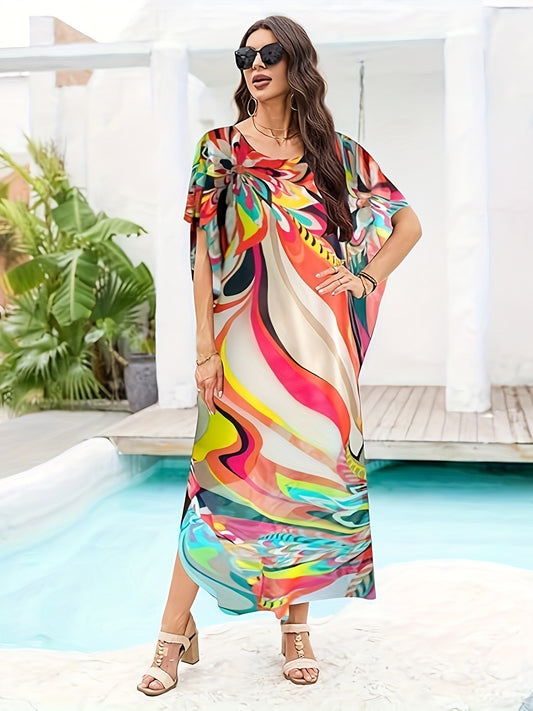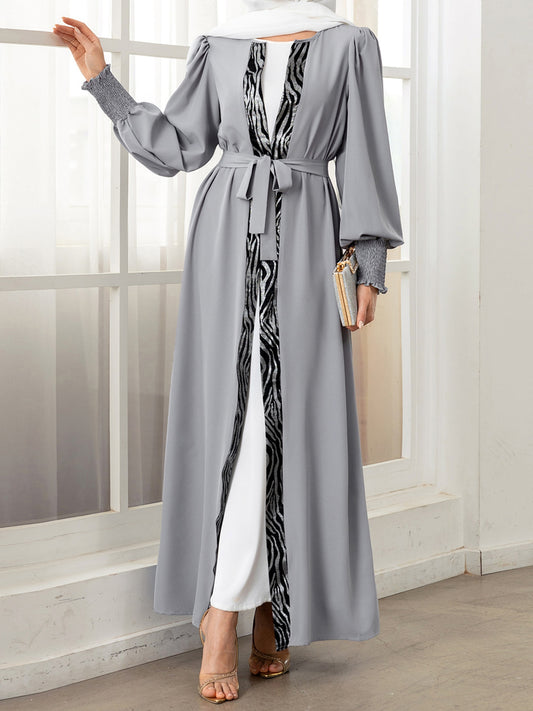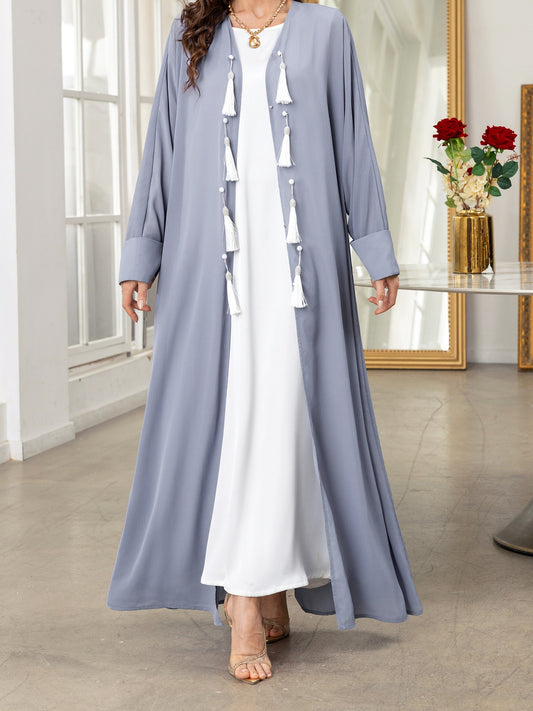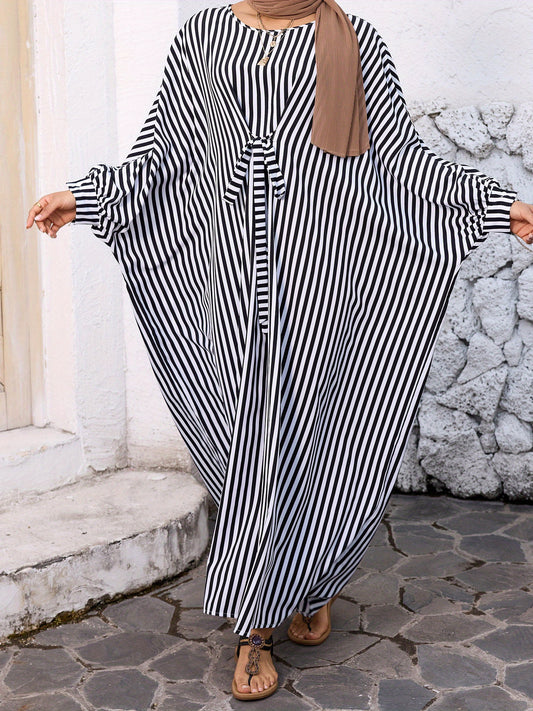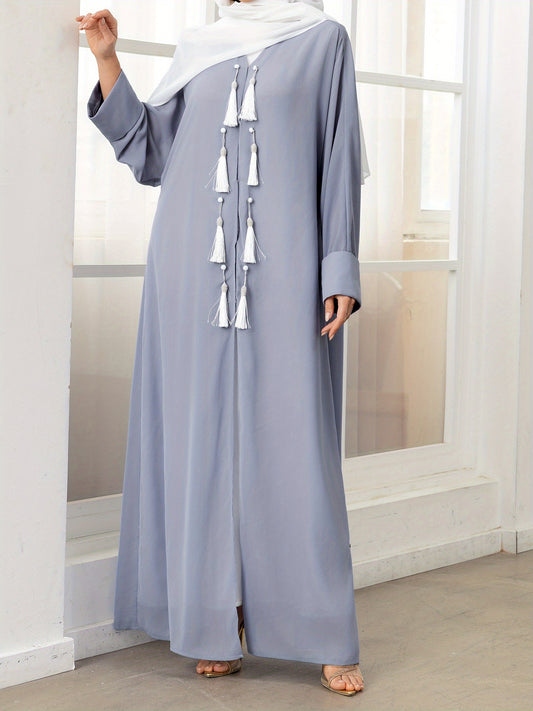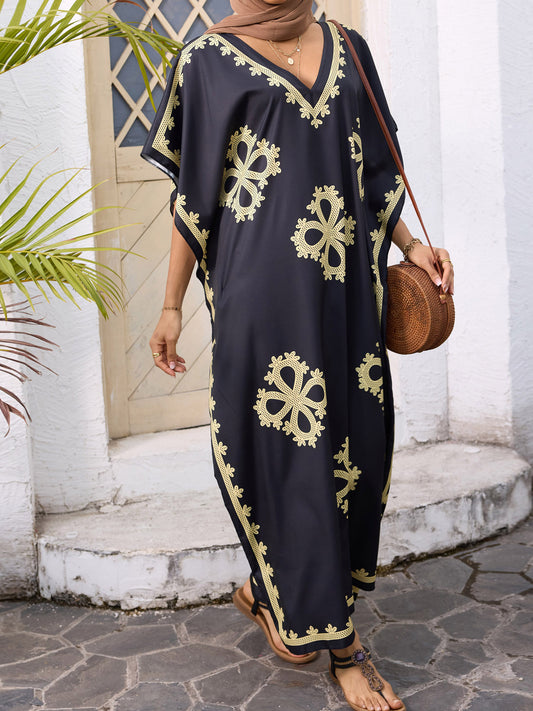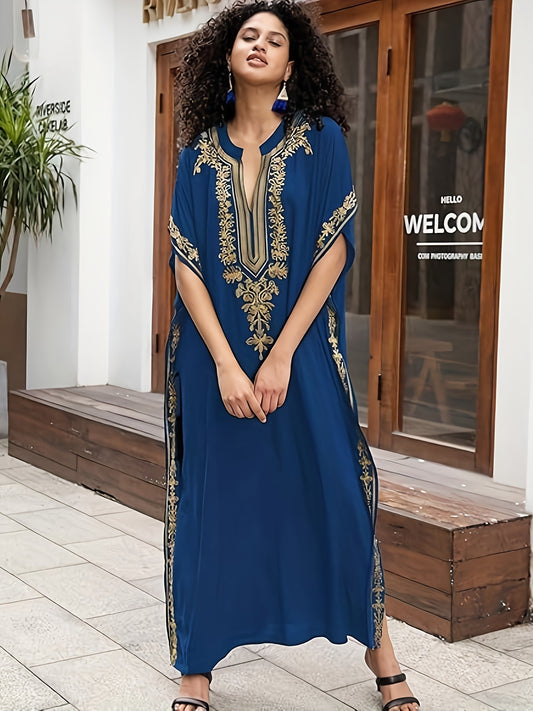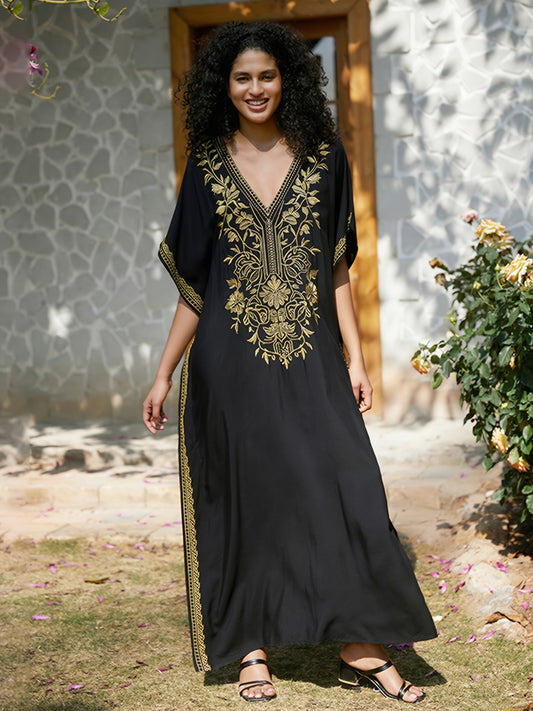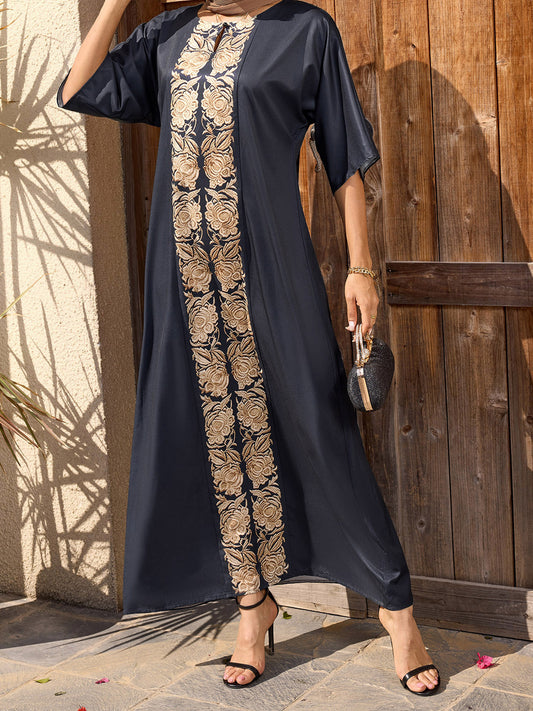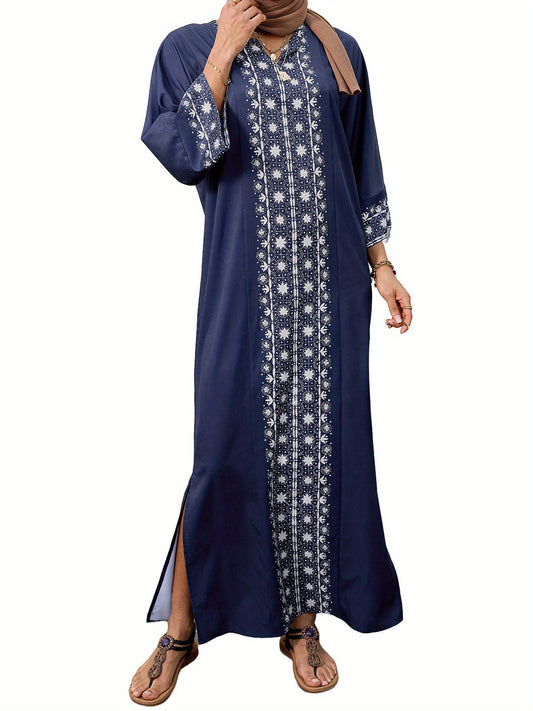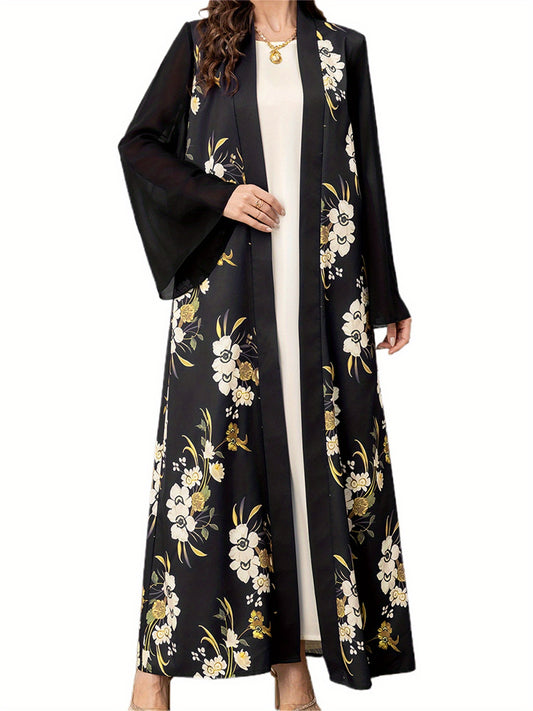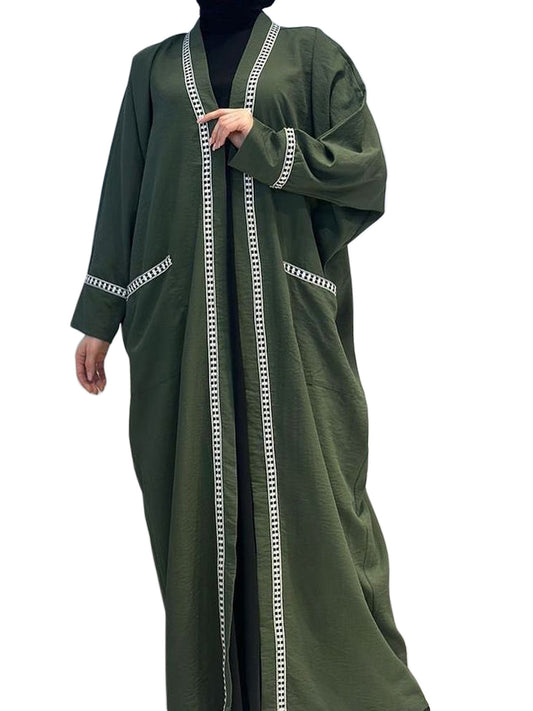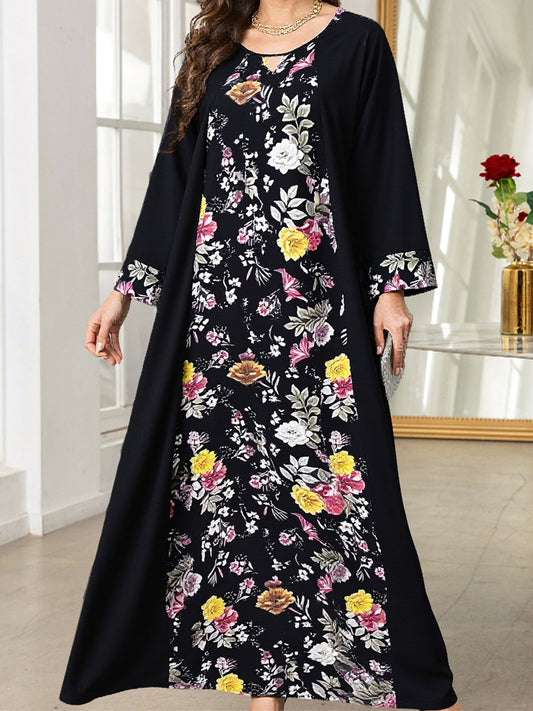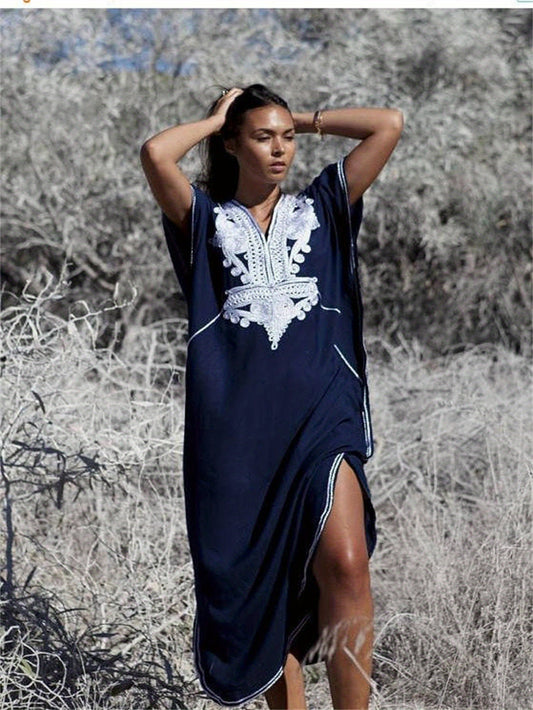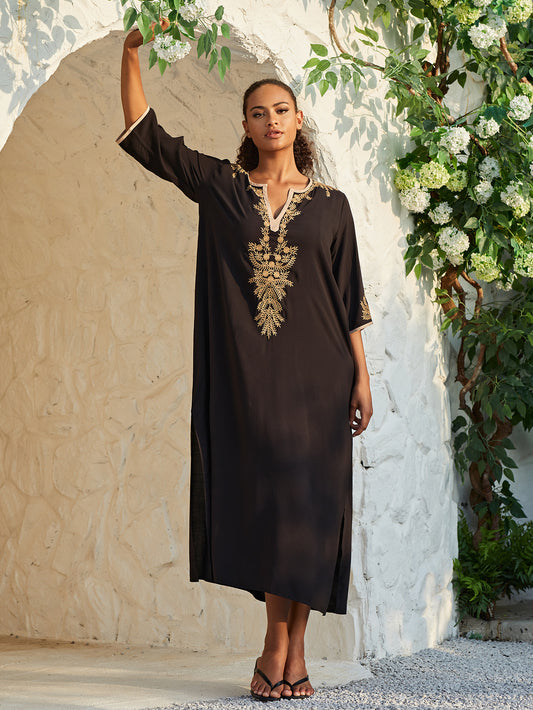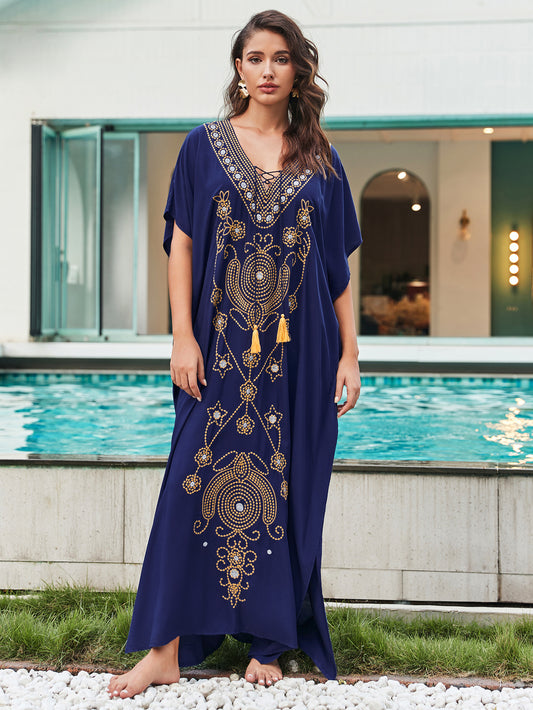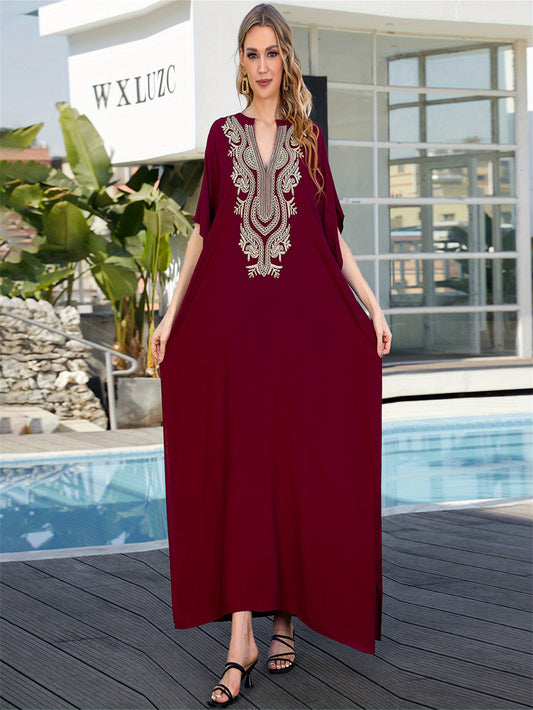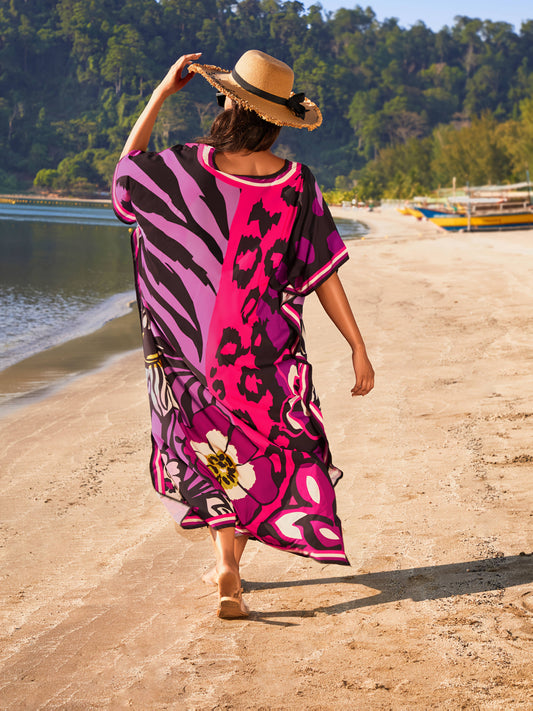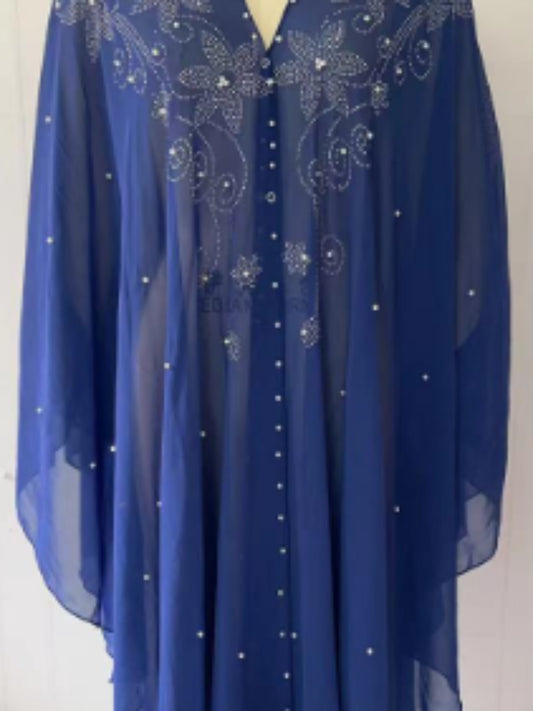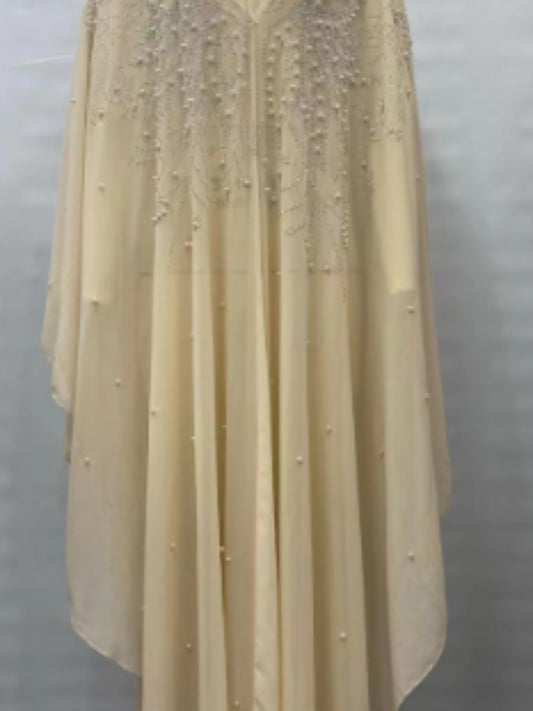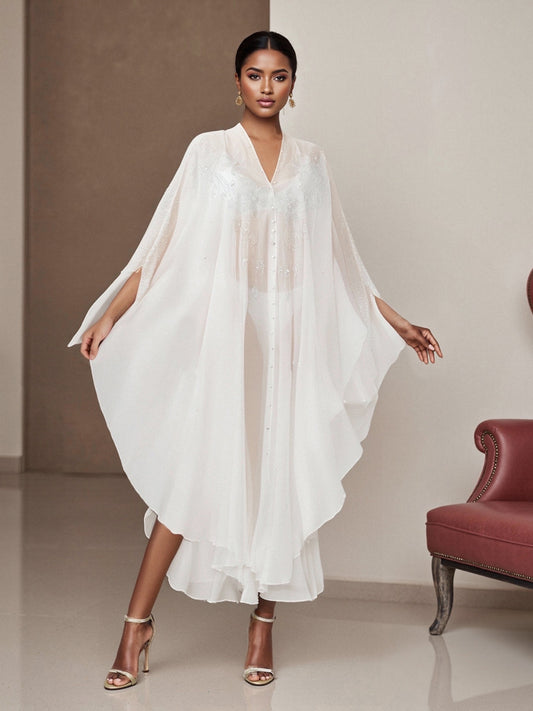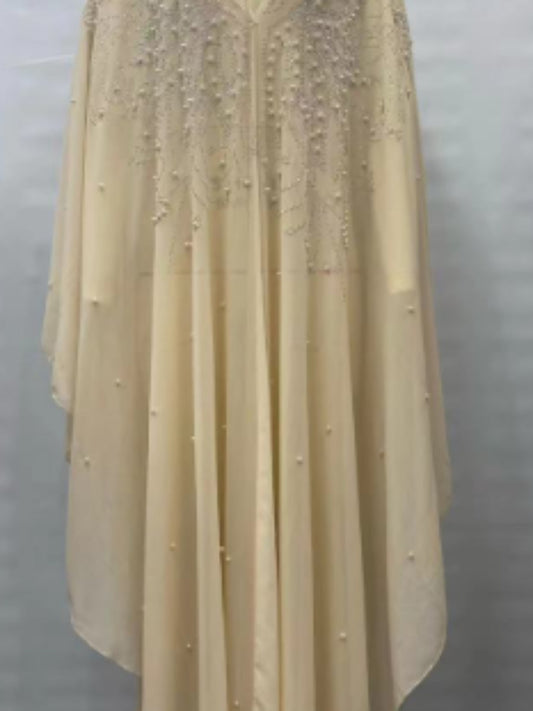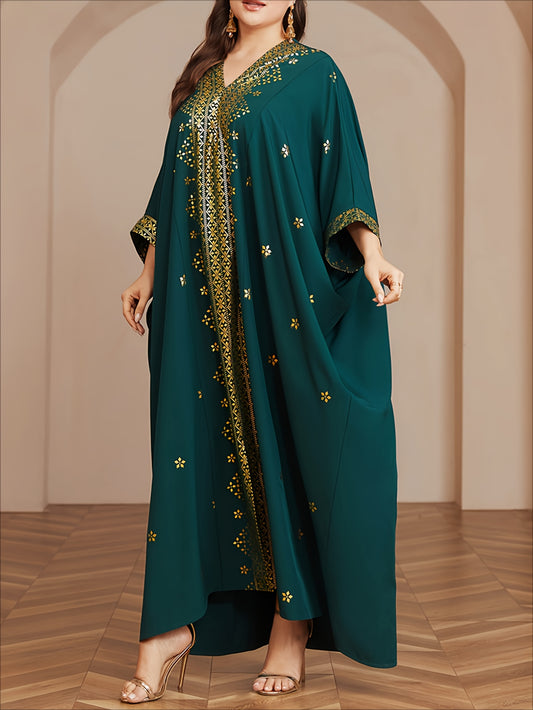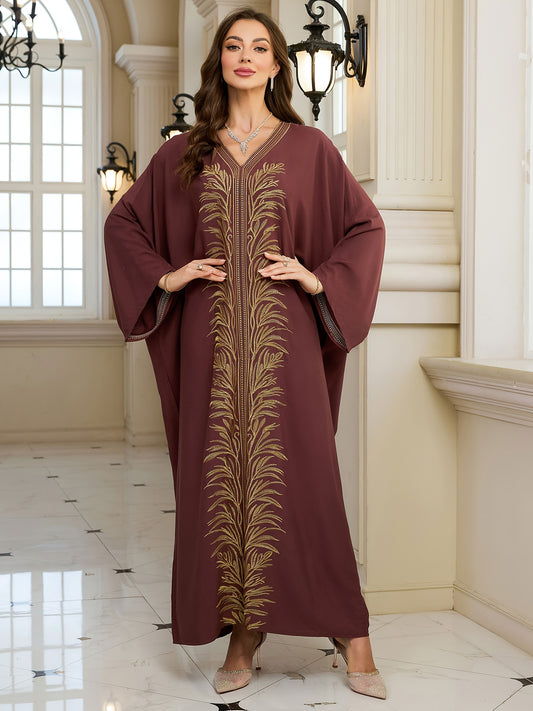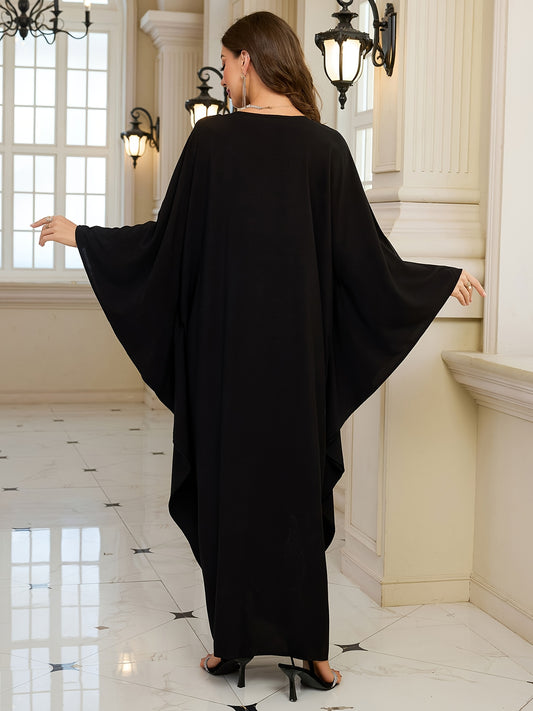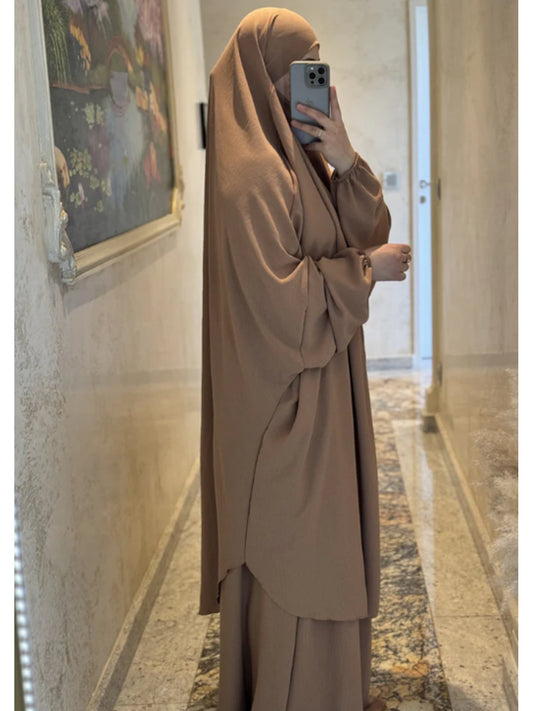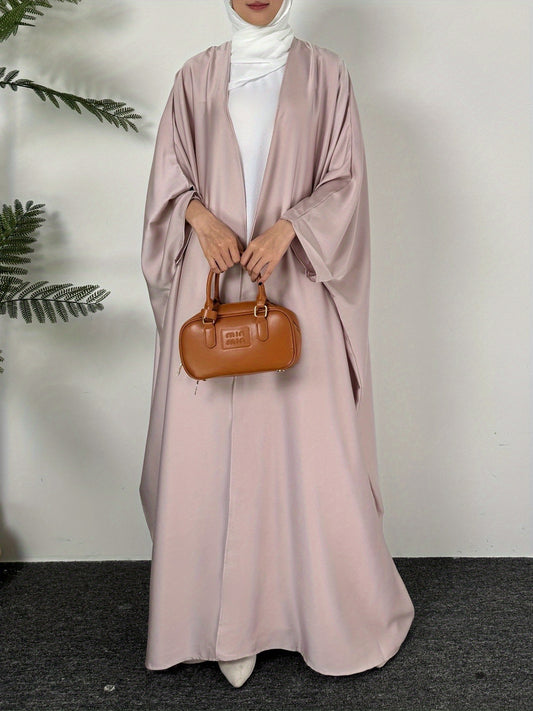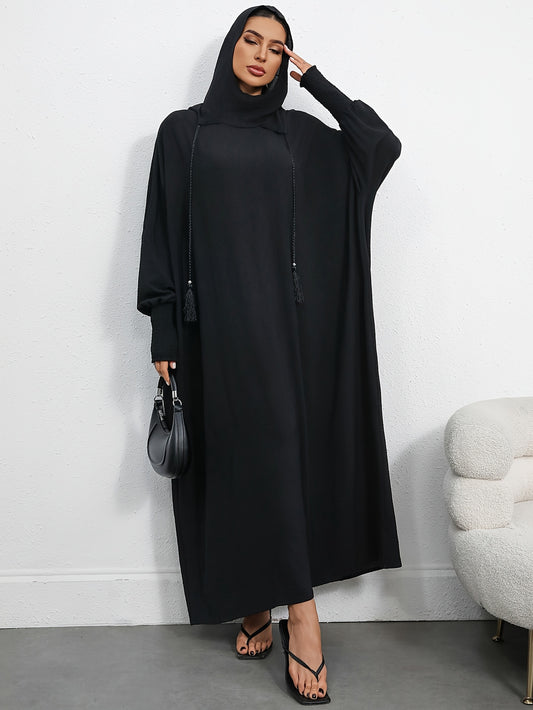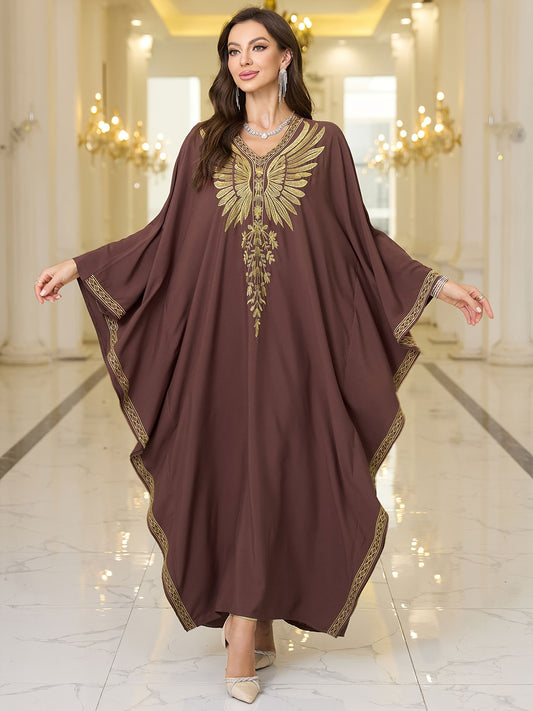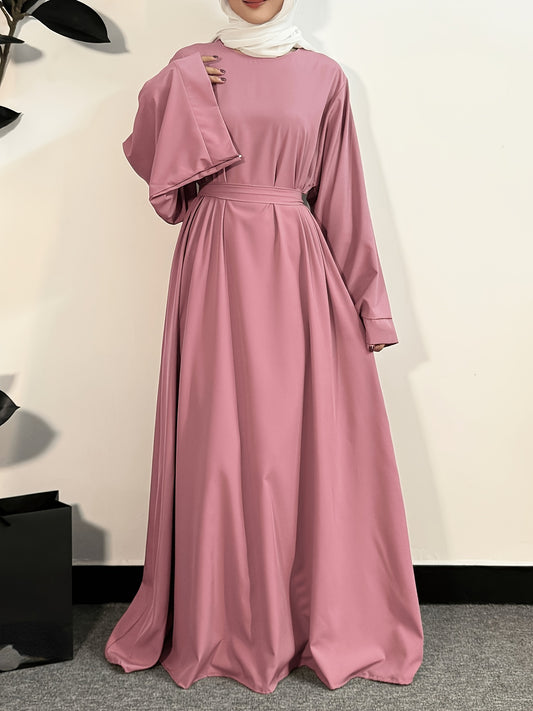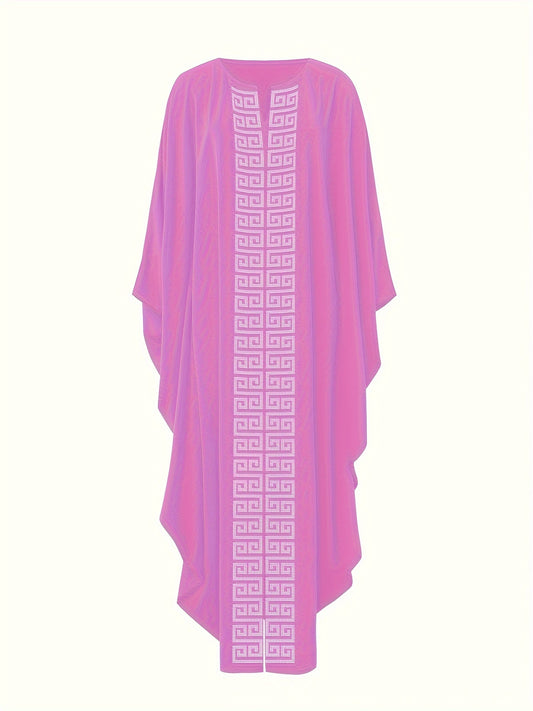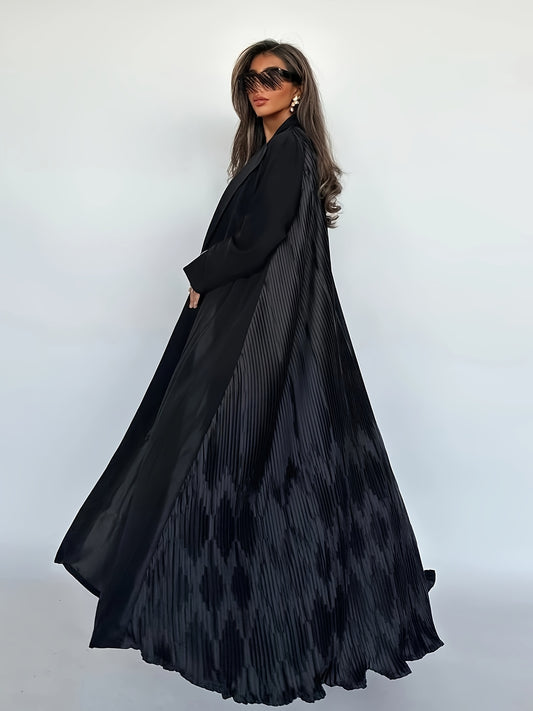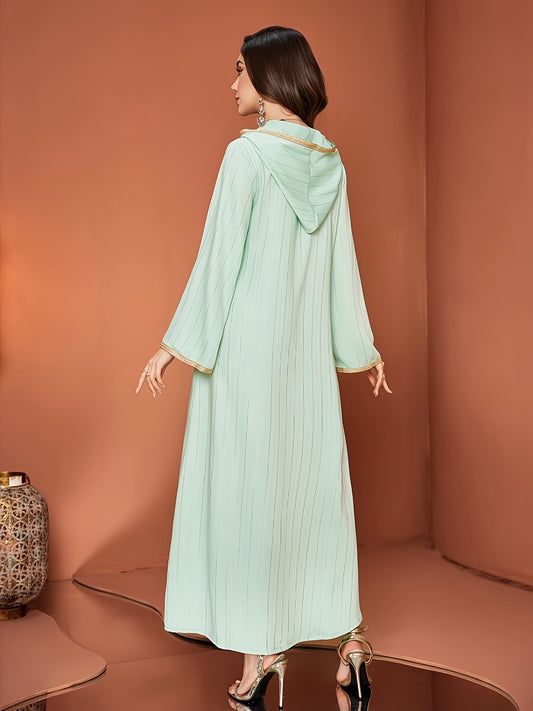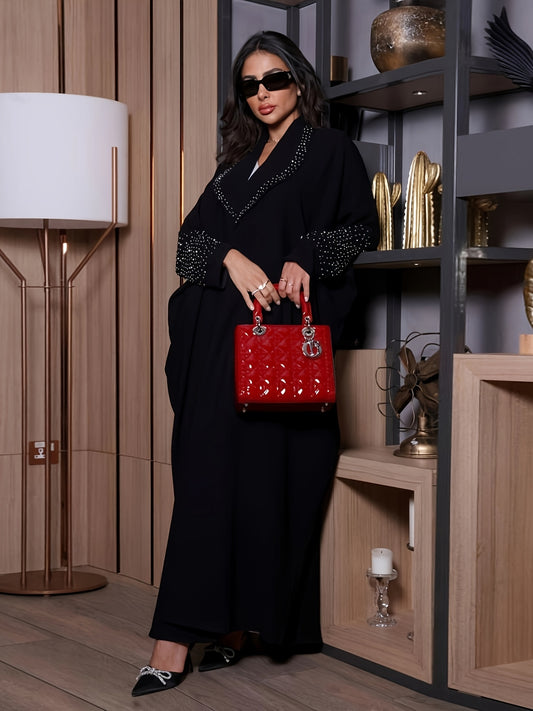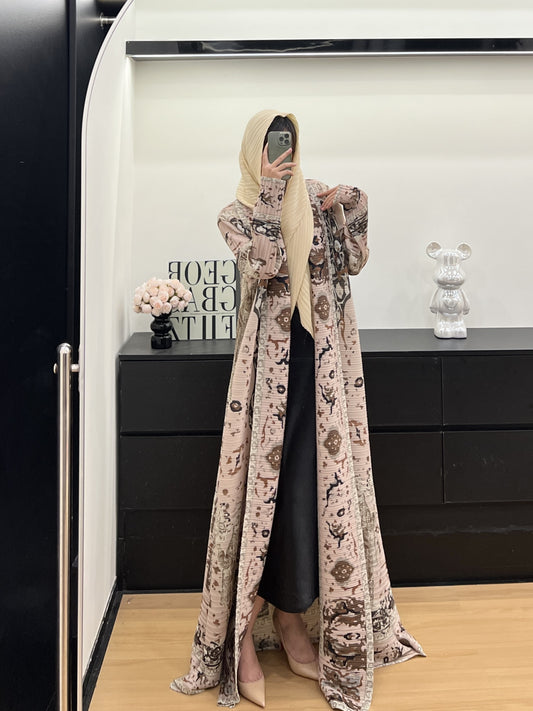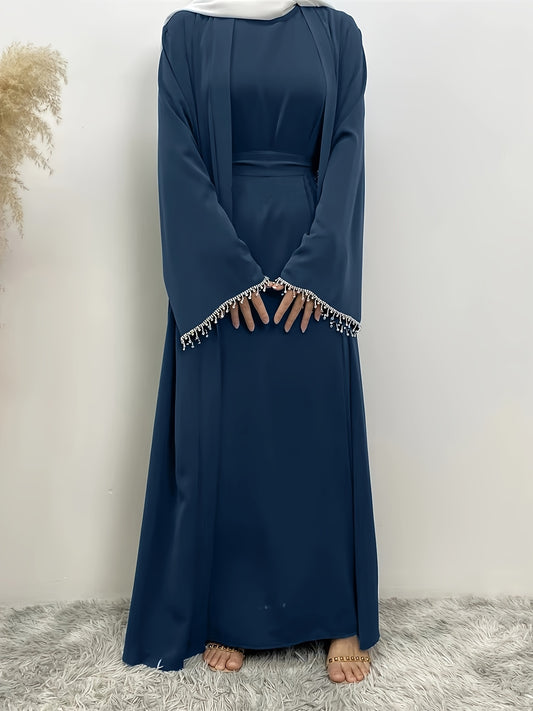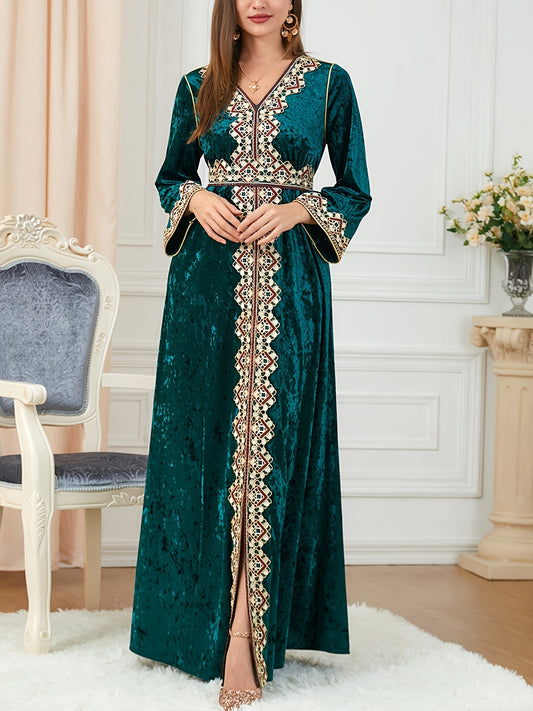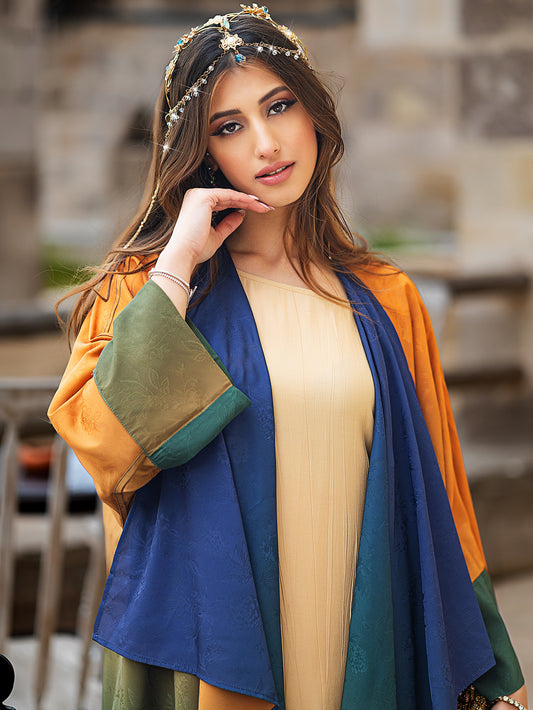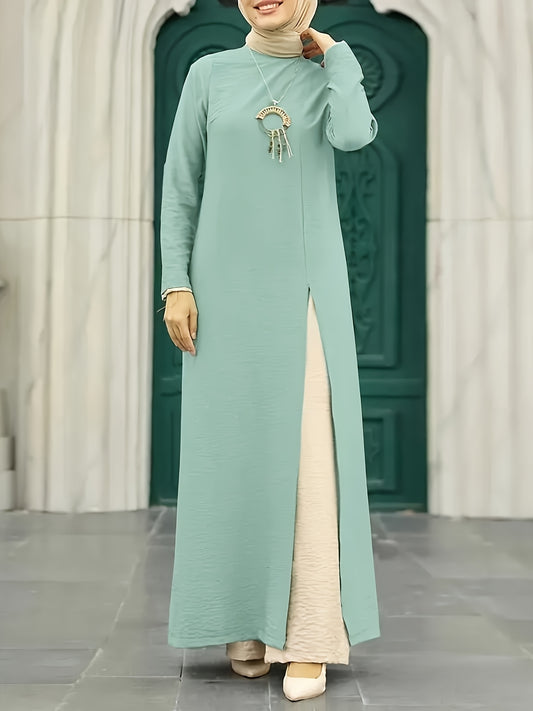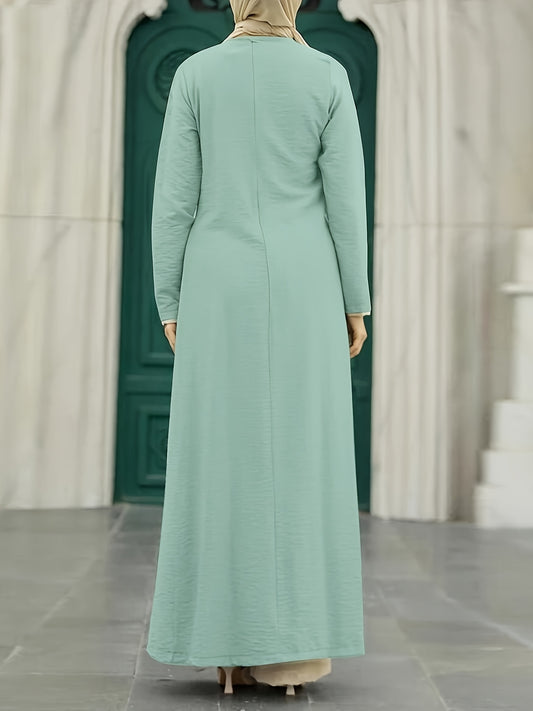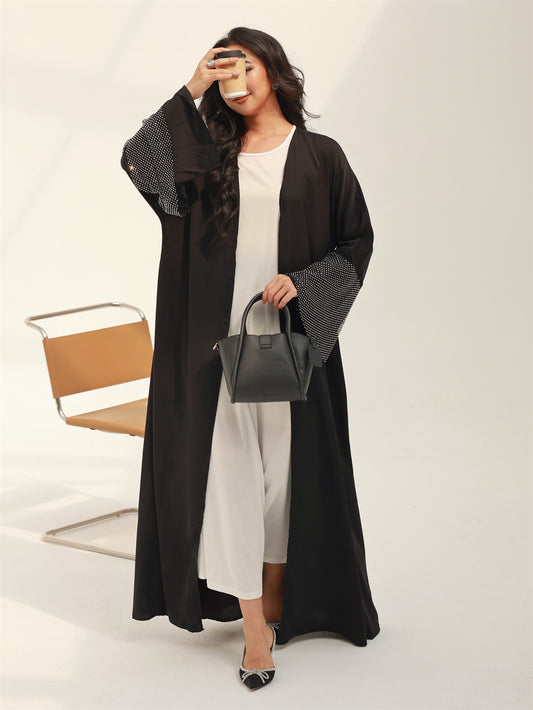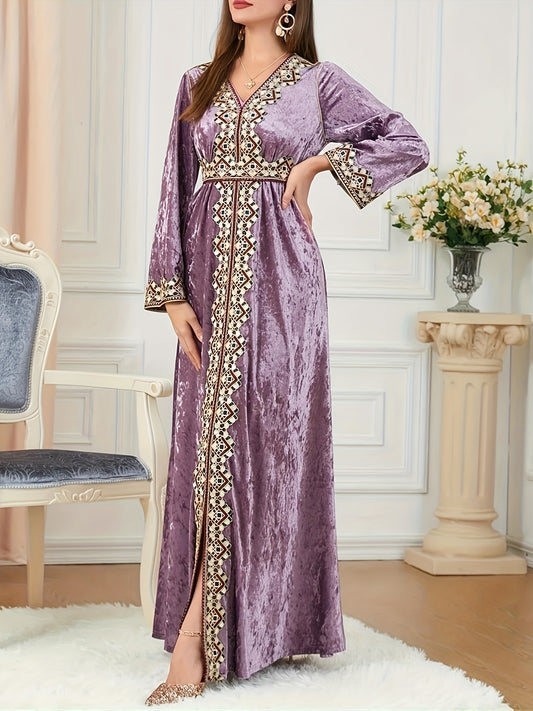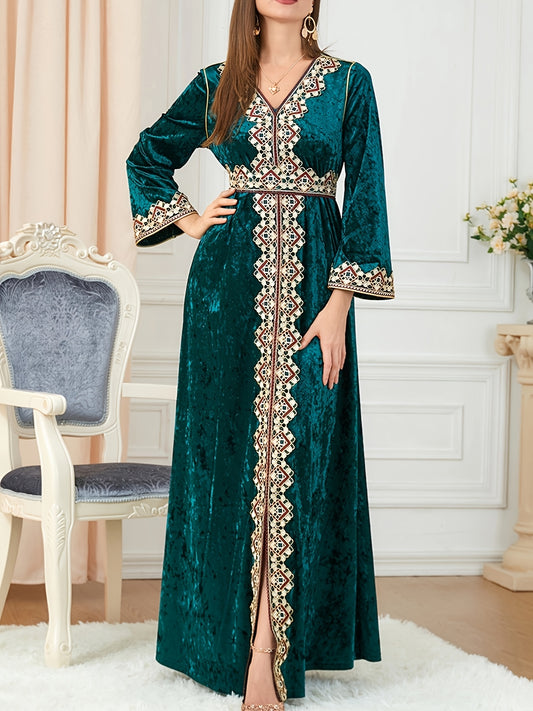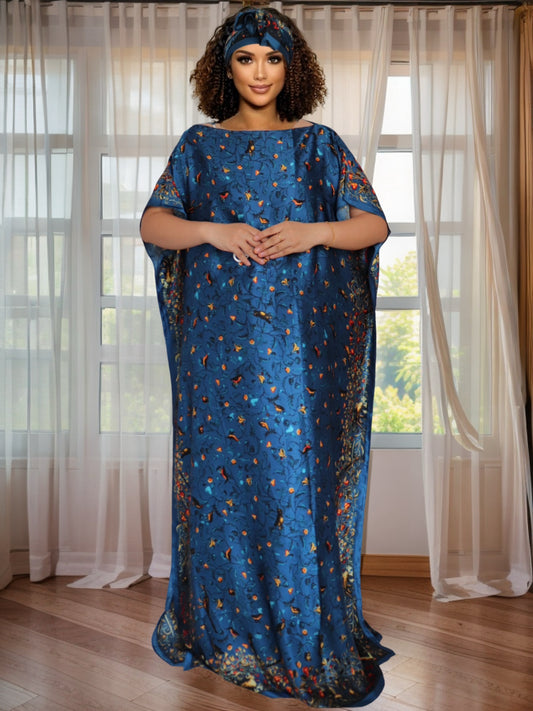About Kaftan
The Complete Guide To Kaftans
Introduction To The Kaftan
The kaftan is one of fashion’s most enduring silhouettes, a fluid garment that travels effortlessly between cultures, climates, and centuries. Defined by its generous cut, relaxed drape, and unfussy elegance, the kaftan slips over the head and skims the body with grace, offering freedom of movement without compromising style. In modern wardrobes it can function as resort wear, eveningwear, loungewear, or a refined layering piece, shifting from barefoot beaches to candlelit dinners with a change of accessories and intent. What distinguishes a kaftan from other dresses is the way it mediates space: the cloth floats away from the body, creating a column of air that cools, flatters, and frames the wearer. Because the silhouette is so considered, it invites extraordinary variety in fabric, color, and surface detail.
Historical And Cultural Origins
The kaftan’s genealogy winds through North Africa, the Middle East, Anatolia, Persia, and the Indian subcontinent, with variations documented from court garments to everyday dress. Ottoman sultans commissioned kaftans woven with brocaded silks and gilt thread; Moroccan and Algerian versions emphasized embroidery and luminous color; West African boubous and East African kanga offered parallel expressions of flowing dignity. As trade routes moved fabrics and motifs, the kaftan absorbed influences—ikat from Central Asia, ajrak block prints from Sindh, sfifa braiding from Morocco—while retaining its essential premise of ease, coverage, and ceremony. The 20th-century revival saw designers reinterpret the form for cosmopolitan life, translating artisanal textiles into garments that worked for galleries, verandas, and ocean liners alike. Today, the kaftan persists because it reconciles tradition with the needs of contemporary dressing: comfort, modesty options, and instant polish.
Design Principles And Silhouette
A great kaftan is governed by proportion, line, and balance. Three foundational silhouettes dominate: straight column, A-line flare, and cocoon volume. Necklines range from jewel and bateau to V-neck and split-neck; sleeves may be cut-on, kimono, angel, or bracelet length. Side slits add stride and airiness, while subtle shaping at the shoulder prevents excess bulk. Length is strategic: ankle-grazing for formal presence, midi for day-to-night agility, mini for beach layering. Designers manipulate negative space to keep the garment light on the eye, using vertical seams, engineered borders, or piping to outline the body without revealing it. For prints, placement is architecture: a medallion centered at the sternum anchors the gaze; a shadow border at the hem grounds movement; diagonal motifs tilt the figure forward in motion. The aim is a silhouette that reads intentional, not oversized—a garment that moves with you and frames you, never overwhelming the person inside it.
Materials And Surface Treatments
Fabric determines the mood of a kaftan. Silk crepe moves like water and elevates evening settings; matte georgette diffuses light and photographs beautifully; chiffon floats with ethereal transparency; viscose and Tencel deliver breathable drape with easy care; cotton voile and lawn feel crisp in heat; linen blends introduce texture and coolness. For cooler seasons, satin-back crepe, velvet devoré, and fine wool gauze offer depth. Surface treatments refine the narrative: hand embroidery, zardozi, mirror work, and beadwork can shift a simple silhouette into ceremonial territory; digital prints allow crisp artwork with efficient dye use; discharge printing reveals luminous grounds under darker fields. When ornament is used, it should be placed where the garment carries weight—neckline, cuff, hem—so embellishment stabilizes the cloth rather than dragging it down.
Functionality And Fit Engineering
While the kaftan appears effortless, intelligent engineering underpins comfort. Shoulder slopes are calibrated to avoid slipping; facing or bias binding stabilizes necklines; hidden snaps secure modesty at the chest; in-seam pockets preserve the line without bulk; micro-covered elastic at the cuff allows adjustability; side slits are reinforced to resist stress. Many designers include internal ties to subtly shape the waist from the inside, preserving exterior minimalism. Travel-friendly versions in wrinkle-resistant crepe or twill can be rolled, not folded, and steamed back to life in minutes. True luxury shows up in the invisible: even top-stitching, matched motifs at seams, and hems that skim parallel to the floor.
Regional Variations And Motifs
Regional vocabularies keep the kaftan culturally resonant. Maghrebi styles favor luminous jewel tones and sfifa trims; Levantine pieces often pair geometric embroidery with fine lawn; Turkish influences lean into striped silk and metallic ribbon; Persian aesthetics celebrate garden motifs and pomegranate symbols; South Asian interpretations play with bandhani dots, ajrak geometry, resham threads, and gota laces; West African couture explores wax prints and indigo resist with dramatic sleeve profiles. Contemporary designers remix these dialects, but respectful citation remains essential—honoring techniques and communities sustaining them.
Occasions And Use Cases
Versatility is the kaftan’s signature. A lightweight cotton piece anchors summer city dressing with leather sandals and a structured tote. Sheer chiffon layered over a slip becomes cocktail-appropriate under chandelier earrings. On holiday, a quick-drying viscose kaftan doubles as a pool cover-up by day and a belted dinner dress by night. Brides select ivory silk kaftans for pre-wedding rituals, while mothers of the couple appreciate elegant coverage without heaviness. At home, a cozy brushed modal kaftan turns reading afternoons into rituals of care. Few garments pivot so elegantly across work, leisure, travel, and ceremony.
Color, Print, And Pattern Strategy
Color strategy amplifies silhouette. Saturated jewel tones—emerald, garnet, sapphire—deliver ceremony; earth neutrals ground daytime looks; seaside palettes of aqua, sand, and shell feel resort-ready; monochrome black is sculptural and photographic. Strategic print placement matters: vertical vines elongate; shadow borders define the hem; engineered medallions center the gaze; micro-prints soften volume; ombré transitions add movement. Designers consider complexion and context, offering warm and cool interpretations of signature palettes so clients can build cohesive wardrobes that age gracefully in photographs and memory.
The Fabulive Perspective On Quality
Within a crowded market, Fabulive emphasizes fabric integrity, timeless artwork, and meticulous finishing. Collections lean into breathable fibers, thoughtful lining choices, and durable trims engineered for repeated wear. Fabulive’s editing prioritizes pieces that move from daytime minimalism to evening polish with a change of accessory, reflecting a belief that the best kaftan works hard, feels weightless, and endures season after season.
Textile Science: Handle, Drape, And Breathability
Behind the romance of a sweeping kaftan lies the physics of cloth. Handle describes how a fabric feels in hand—silk crepe has spring, georgette has slight grit, linen has dry crispness—while drape describes how the fabric falls over form. Breathability is the fabric’s ability to move moisture and air, governed by fiber type, yarn twist, and weave density. Open-weave cotton voile allows convective cooling; tightly woven satin traps more warmth and reads dressier. Designers exploit these variables: a slightly heavier crepe sharpens the garment’s outline, while a gauzy voile creates cloudlike movement in a breeze.
Craft Techniques That Elevate
Elevated kaftans rarely shout; they whisper with detail. Hand-rolled hems prevent rippling at curved edges. French seams hide raw edges for longevity, crucial when translucent fabrics are used. Beading should be applied with thread guards and secure knots so that a single pulled bead does not compromise a motif. Engineered prints must mirror at center front, and border placements should align at side seams so the eye reads continuous lines. A quality garment reveals its craft when turned inside out—the finishing is tidy, the interfacing is subtle, and the stitches are consistent.
Measurement And Sizing Intelligence
Sizing labels vary globally; precise measurements de-risk online orders. Bust circumference and across-shoulder width determine the clean sit of a kaftan, while garment length interacts with footwear height. Sleeve girth affects airflow and range of motion; a narrow wrist opening appears refined but must stretch or fasten to allow dressing. When in doubt, compare the posted size chart with a dress you already own, measured flat. Many buyers prefer a relaxed fit that skims rather than clings; tailoring a hem or sleeve to your proportions is usually simple and extends longevity.
Climate, Travel, And Performance
Climate resilience distinguishes an everyday kaftan from a true wardrobe hero. In tropical humidity, capillary-active fibers like viscose and cotton wick moisture, while underarm gussets add mobility and reduce abrasion. In arid heat, linen’s hollow fibers disperse warmth; wide sleeves promote micro-ventilation. For cool evenings, a satin-back crepe worn over a fine knit provides insulation without bulk. Frequent travelers appreciate wrinkle-resistant twills and crepes that emerge ready to wear from a suitcase; a handheld steamer becomes a trusted companion.
Modularity With Other Wardrobe Pieces
Treat the kaftan as an ecosystem node that connects accessories and separates. Over a slim turtleneck it reads architectural in winter; over tailored trousers it becomes a long tunic for work; over swimwear it functions as a refined cover-up. A soft leather belt changes energy from artful to tailored. Footwear reprograms tone too: leather slides for weekend ease, block-heel sandals for gallery openings, bejeweled flats for celebrations. Because the garment’s lines are simple, small swaps have outsized impact.
Styling Frameworks For Different Lifestyles
A kaftan is a wardrobe algorithm: one silhouette, infinite outputs. Build capsule formulas that solve recurring scenarios. For creative offices, pair a matte crepe midi with refined flats, a structured tote, and modern hoops; add a belt for meeting-ready definition. For travel, a wrinkle-resistant viscose maxi, leather slides, and a crossbody bag create airport-to-dinner continuity. For weekends, cotton voile plus espadrilles and a straw hat reads effortless. Evening calls for silk or velvet devoré, high-shine jewelry, and a compact clutch. Each formula reduces decision fatigue while preserving personal style.
Body Diversity, Comfort, And Confidence
The kaftan does not demand a single body ideal. Instead it negotiates space, light, and movement to flatter. V-necks lengthen the neckline; bracelet sleeves reveal the slimmest part of the arm; side slits release volume at the calf; a column cut elongates petite frames; an A-line creates sculpture for curvier bodies. Petite clients can hem above the ankle to expose more vertical line; tall clients can lean into extra length and larger prints. Many women report the kaftan’s psychological ease—the liberation of feeling elegant without armor or compression—making it a garment that supports presence rather than self-consciousness.
Accessory Strategy And Footwear
Accessories are multipliers. With minimal day dresses, choose tactile accents: hammered metal cuffs, rope belts, woven leather slides. For evening, switch to crystal earrings, a sleek belt chain, and strappy heels. In colder climates, layer with a tailored coat, tights, and knee boots. Bags should echo proportion: a slim clutch for formalwear, a structured medium tote for day. Headscarves, turbans, or silk bands can frame the face and protect blowouts, while sunglasses with architectural lines modernize floaty fabrics.
Layering And Modesty Options
Kaftans excel at modular modesty. A tonal slip manages sheerness without visual noise. Fitted jersey tops under sleeveless kaftans add coverage without bulk. Lightweight dusters or kimonos create depth while respecting climate. For prayer or moments that require extra discretion, hidden snaps and interior ties allow quick adjustments. Fabric choice supports values: opaque crepes and lined chiffons maintain lightness without transparency, offering serene confidence in diverse settings.
Care, Laundering, And Longevity
Maintenance determines lifespan. Dry clean silk, velvet, and beaded pieces; hand wash chiffon and georgette with a silk-safe cleanser; machine wash cotton voile and viscose on delicate in a mesh bag. Press with a cool iron from the reverse or use steam to revive drape; avoid crushing sequins or beadwork with direct heat. Store on padded hangers, closing zips and snaps to preserve shape. For travel, roll rather than fold, and hang in a steamy bathroom on arrival to release creases. Small repairs—re-securing beads, restitching slit bar tacks—pay for themselves in years of extra wear.
Sustainability And Traceability
Responsible kaftans begin with fiber. Preferred textiles include organic cotton, linen grown with low irrigation, Lenzing-certified viscose, peace silk, and recycled polyester chiffons that divert waste. Low-impact reactive and digital inks reduce water use in printing; natural dyes reclaim plant by-products. Transparent supply chains protect artisan communities, from block printers and embroiderers to cutters and finishers. Packaging moves to recycled paper, plant-based polybags, and minimal swing tags. Buyers can support better systems by choosing fewer, better pieces and extending garment lifecycles through care and repair.
Regional Dress Codes And Cultural Sensitivity
Styling a kaftan across borders invites respect. In the Gulf, floor-length silhouettes with subtle sparkle suit evening gatherings; in North Africa, bright color and sfifa trims celebrate heritage; in South Asia, printed cotton daywear and embroidered evening pieces coexist; in Mediterranean resorts, crisp whites and nautical stripes feel right. The goal is resonance, not costume: adopt elements thoughtfully, credit inspiration, and support makers who steward these traditions.
Event-Ready Capsules
Create micro-capsules to remove decision fatigue. For beach weddings: chiffon kaftan, metallic flat sandals, shell earrings, clutch. For black-tie: silk crepe kaftan with satin binding, statement cuff, slingback heel. For work travel: midi crepe kaftan, belt, block-heel mules, structured tote. For family celebrations: embroidered georgette with modest lining, glimmer studs, comfortable wedges. Each capsule emphasizes ease without diluting occasion.
The Fabulive Approach To Curation
Fabulive’s kaftan selection centers on wearability, craftsmanship, and seasonless beauty. Pieces are vetted for fabric handfeel, drape integrity, and finishing details like clean hems, secure beading, and thoughtfully placed pockets. The brand offers size-inclusive runs and clear garment measurements, streamlining online selection so clients can shop confidently and build enduring, mix-and-match capsules.
Print Languages And Visual Architecture
Print is structure. Stripes set rhythm and direction; tiles and trellises build order; florals soften volume; animal motifs add bravado. Scale management is key: oversized motifs suit tall frames and formal spaces; micro-prints flatter petites and daylight wear. Engineers of great kaftans place borders to frame the face and hem, echoing the logic of classical architecture—cornice, frieze, column. Where prints meet at seams, alignment signals quality. Subtle contrast piping along the neckline or cuff can trace the silhouette and read as jewelry when minimalism is desired.
Seasonal Capsules And Regional Weather
A three-season plan simplifies dressing. Spring: cotton voile with botanical prints, mid-calf length, canvas espadrilles. Summer: linen blend or sheer chiffon with slip, natural straw accessories, minimal jewelry. Autumn: matte crepe with bracelet sleeves, ankle boots, sculptural earrings. In monsoon regions, choose quick-drying viscose and secure hems to avoid splashing; in desert climates, emphasize light colors that reflect heat and avoid metal hardware that warms under the sun. City winters invite velvet devoré layered under an elegant coat.
Professional Codes And Visual Authority
In client-facing roles, the kaftan must balance personality with authority. Choose saturated solid colors, restrained prints, and clean finishing. Midis that reveal the ankle read decisive. Keep accessories graphic rather than ornate—geometric earrings, smooth leather belts, structured bags. When presenting on stage, matte fabrics avoid glare under lights, while a defined neckline frames microphones and lanyards. The goal is focus: calm presence, clear message.
Photography, Video, And Event Lighting
Cameras interpret texture differently from the human eye. Fine chiffon can appear overly sheer under LED; silk crepe reads rich on film; sequins flare under spotlights. Test outfits in the lighting you expect and record a short clip to review movement and shine. Avoid small high-contrast prints that strobe on video; favor larger or lower-contrast artwork.
Repair, Restoration, And Aftercare
Great garments deserve care with a long horizon. Store beaded pieces flat in tissue to avoid stretching. Mend pulled threads with a fine needle and patience, re-anchoring beads to a nearby seam allowance. Address deodorant or sunscreen marks promptly with a gentle cleanser. Sun fade can be mitigated with mindful rotation—alternate pieces rather than over-wearing a favorite. When a kaftan retires from formal rotation, dyeing a faded light piece a deeper shade can extend its life.
Buyer’s Guide: Fit, Fabric, And Finish
Select kaftans by aligning context, climate, and care. For hot, humid weather, prioritize cotton voile, linen blends, or Tencel with airflow and quick dry. For evening, choose silk crepe, satin-back crepe, or velvet devoré for depth under low light. If you require modesty without heaviness, opt for lined chiffon or opaque georgette. Inspect finishing: even top-stitching, secure seams at slits, smooth facings at the neckline, and balanced print placement. Photograph fabric in daylight to evaluate color accuracy and texture; movement in video reveals drape truthfully.
Investment Logic And Cost Per Wear
A kaftan truly rewards repetition. When a garment solves multiple scenarios, cost per wear drops quickly. Consider a silk crepe style at a higher price that functions for dinners, receptions, and travel evenings; amortized over two seasons of regular use, it becomes more economical than buying several disposable dresses. The same logic applies to quality linings and durable trims: they prevent early failure, reducing replacement frequency and waste. Choose fewer, better pieces that integrate across footwear and accessory families you already own.
Digital Shopping And Color Matching
Online color can drift. Study product photos on different screens, then read color names and fabric descriptions for clues—“cool emerald,” “warm sand,” “rose gold lurex.” Look for videos to observe drape. Measure your best-fitting dress flat and compare to size charts rather than relying on numeric labels alone. Community reviews that mention height, size, and fabric feel are valuable context. If between sizes, prioritize shoulder fit and sleeve mobility; volume elsewhere is forgiving and can be belted or tailored later.
FAQs
What is the difference between a kaftan and an abaya? An abaya is typically an over-garment with front opening; a kaftan is a closed-front dress or tunic with more variation in necklines and sleeves. Can a kaftan be formal? Absolutely—silk, beadwork, or engineered prints elevate the silhouette to gala territory. Is the kaftan suitable for petite heights? Yes; hem to ankle and favor vertical motifs. How do I prevent static or cling? Choose breathable fibers, use antistatic spray if needed, and avoid overly synthetic slips. Can I belt a kaftan without ruining the line? Yes—use a soft sash or slim leather belt placed slightly above the natural waist; interior ties help preserve exterior smoothness. Does a kaftan work in cold climates? Layer over thermal knits, add opaque tights and boots, and choose heavier fabrics like satin-back crepe or velvet.
Return On Style: Long-Term Value
The kaftan’s long arc across history is proof of concept. It avoids the obsolescence that traps trend dresses, retaining relevance as tastes shift toward ease and authenticity. Photographs across years look consistent because volume, proportion, and fabric do the aesthetic work. For clients building investment wardrobes, a trio—a day cotton, an evening silk, a travel-proof viscose—covers 80 percent of scenarios. Add a statement embroidered piece for ceremonial use, and the category is complete.
Inclusivity, Accessibility, And Wellbeing
The kaftan affirms that comfort is not the enemy of beauty. It accommodates fluctuating bodies, sensory needs, and mobility considerations without telegraphing compromise. Clients managing temperature sensitivity appreciate airflow; new mothers value ease; mature clients welcome coverage that feels chic, not apologetic. Inclusive sizing, thoughtful pattern grading, and clear measurement charts convert intention into reality, making the category genuinely democratic.
Careers, Creativity, And Cultural Capital
A well-curated kaftan signals discernment. In creative industries it communicates worldliness; in hospitality it reads gracious; on stage it creates presence without distraction. Because it carries echoes of multiple geographies, it also invites conversation—about craft, materials, and responsible consumption—turning clothing into soft power.
The Fabulive Promise
Fabulive advocates for beautiful, durable kaftans made with respect for people and place. Through careful vendor selection, transparent fiber stories, and consistent quality control, Fabulive’s clients gain pieces that feel good today and hold up tomorrow. Collections are refreshed thoughtfully, privileging artwork and fabrics that stand beyond a single season so wardrobes grow smarter, not larger.
Sourcing, Craft Communities, And Equity
Many kaftans move through the hands of artisans whose knowledge is inherited across generations. Block printers in Rajasthan carve teakwood stamps; embroiderers in Fez pass sfifa techniques from master to apprentice; Istanbul’s silk ateliers handle striped ikat with musical precision. Fair contracts, living wages, and safe workshops are the foundation of excellence. When brands publish maker stories and certifications, buyers can align elegance with ethics and help sustain endangered crafts.
Checklist For Quality Verification
Before purchasing, run an audit. Are seams straight and evenly tensioned? Are prints mirrored at center front and matched at side seams? Do beads lie flat without puckering the ground fabric? Are slits cleanly bar-tacked? Is the neckline stabilized to resist stretching? Is the hem smooth with no ripples? Does the garment hang symmetrically on a hanger? Five minutes of inspection can prevent years of regret.
Extended FAQs
Can I tailor a kaftan? Yes. Hemming and sleeve adjustments are straightforward; taking in the body is possible when side seams are straight. What slip should I use under sheer pieces? A bias-cut viscose slip in a shade close to your skin offers invisibility and comfort. How many kaftans does a minimalist wardrobe need? Many find three to four cover most occasions: off-duty cotton, polished day crepe, travel-ready viscose, evening silk. What if my climate is very humid? Favor open weaves, airy sleeves, and absorbent natural fibers; carry a compact steamer for hotel refresh. Can I machine wash delicate kaftans? Only when labels permit and with mesh bags, cold water, and gentle detergents.
Glossary Of Terms
Ajrak: resist-printed cloth with indigo and madder geometry. Devoré: burnout technique that creates velvet patterns on sheer grounds. Gota: metallic ribbon applique from South Asia. Ikat: yarn-dyed pattern achieved by binding threads before weaving. Sfifa: Moroccan decorative braiding used as trim. Voile: very lightweight plain-weave cotton with airy hand.
Styling Case Studies
City Creative: matte crepe midi, sculptural hoops, white sneakers, camera bag; shifts to dinner with metallic sandals and a cuff. Resort Classic: linen maxi, straw hat, leather slides; evening add-on is a silk scarf and pearl studs. Formal Modernist: black silk crepe with satin binding, slim crystal earrings, slingbacks; hair in a chignon.
Wardrobe Math And Capsule Maps
Approach your closet as a portfolio. Allocate roles rather than duplicating silhouettes. A balanced kaftan capsule spans four lanes: Off-Duty (breathable cotton or linen for errands, parks, markets), Work-Polished (matte crepe midis that accept belts and layer under blazers), Ceremony (silk or embellished georgette for weddings and cultural events), and Travel-Proof (wrinkle-resistant viscose that converts from day to dinner). Assign color families that interlock—desert neutrals, ocean hues, night-jewel tones that travel across seasons without clashing.
Resale, Alteration, And Archival Value
Quality kaftans hold value because they resist timestamping. Solid silks and precisely engineered prints remain desirable on the resale market, especially when original tags, garment bags, or maker notes accompany them. Alteration potential matters: straight side seams and untrimmed hems make size adjustments easier for new owners, extending lifespan. Archive sentimental pieces—pre-wedding ivory silk, a hand-embroidered heirloom—in breathable cotton bags away from light. Document care and provenance with a small card tucked into the garment bag so future owners understand its story.
Brand Evaluation Framework
When comparing labels, move past marketing language to tangible criteria. Fabric pedigree: is the silk denier disclosed, is viscose Lenzing-certified, is cotton organic or BCI? Construction: are stress points reinforced, are facings clean, do pockets distort the line? Artwork: is print resolution sharp, are colors fast, is placement engineered? Ethics: does the brand publish partner locations, wage standards, and third-party audits? Service: are measurements transparent, are hem or sleeve adjustments offered as paid services when needed?
Editor’s Final Checklist
Ensure the piece you choose meets four tests: comfort for a full day, credibility in photographs, compatibility across three shoes and two bags you already own, and care that fits your reality.
Color And Complexion Mapping
Color harmony turns a good kaftan into a great one. Cool complexions with rosy undertones thrive in blue-based jewel tones—teal, sapphire, fuchsia—and in inky black; warm complexions glow in spice and sunlit palettes—terracotta, marigold, olive, chocolate. Neutrals are not universal: creamy ecru can wash out skin tones, while flint gray can deaden others. When uncertain, test fabric near natural light and observe how your face looks before evaluating the garment itself; the right shade sharpens the eyes and lifts the complexion.
Occasion Grid And Dress Codes
Map kaftans to invitations. Garden luncheon: linen midi, woven belt, espadrilles. Cocktail terrace: silk crepe ankle-length, metallic sandal, cuff. Cultural ceremony: embroidered georgette with modest lining, jeweled flat, shawl. Gallery opening: matte black column with architectural earrings and a mule. Long-haul flight: wrinkle-resistant viscose, compression socks, soft slides, oversized scarf as blanket. Clear links between outfit and context transform dressing from stress to muscle memory.
Fabric Care Index At A Glance
Silk Crepe: dry clean or cool hand wash with silk cleanser; steam from reverse, never crush embellishment. Georgette/Chiffon: hand wash in a mesh bag, roll in towel to dry, use a garment steamer. Viscose/Tencel: delicate cycle in cool water, reshape while damp, press gently. Cotton Voile: machine wash cold, line dry, light iron for crispness. Linen Blends: machine wash warm, steam to relax creases, embrace natural texture. Velvet Devoré: specialist clean only; store flat with tissue, avoiding pressure marks from hangers or sharp folds.
The Fabulive Promise Of Continuity
The brand advocates for kaftans that harmonize beauty and responsibility, with transparent sourcing, thoughtful trims, and consistent sizing through ranges so wardrobes can be built methodically. Fabulive remains committed to designs that slip between occasions gracefully, proving that refined simplicity outlasts fashion’s noise.
Customer Reviews
• “I chose a linen-blend kaftan for a week in Dubai and wore it nonstop. It stayed cool, packed flat, and looked polished with flats or heels. After several washes the color held true and the seams are still impeccable—exactly what I wanted for carry-on travel.” – Sarah, USA ⭐⭐⭐⭐⭐
• “The drape of the silk crepe is outstanding. I added a belt for a board dinner and felt both modest and modern. Colleagues asked for the link, and it photographed beautifully under warm restaurant lighting without glare.” – Leila, UK ⭐⭐⭐⭐
• “Color and sizing matched the chart perfectly. The georgette lining kept it opaque without weight. I’ve styled it with sneakers for daytime and with stacked bangles for Eid; it behaves like two dresses in one.” – Amina, Canada ⭐⭐⭐⭐⭐
• “My velvet devoré kaftan drew compliments at a winter wedding in Munich. Warm enough with a coat, glamorous indoors.” – Marta, Germany ⭐⭐⭐⭐
• “As a new mom, I appreciate the easy nursing access from the discreet snap neckline.” – Noor, UAE ⭐⭐⭐⭐⭐
• “The border print is aligned and the seams are impeccable. It looks far more expensive than it was.” – Sofia, Italy ⭐⭐⭐⭐⭐
• “Great travel companion for Sydney in summer—light, breathable, and quick to refresh with steam.” – Yasmin, Australia ⭐⭐⭐⭐
• “Customer service helped me compare shoulder widths. The fit is relaxed but intentional.” – Iman, France ⭐⭐⭐⭐⭐
• “I’m 5'2” and hemmed to the ankle as advised. The proportion is perfect and elongating.” – Hanna, Spain ⭐⭐⭐⭐⭐
• “Loved the fabric, though I wish the side slits were a touch higher for bigger strides.” – Omar, Saudi Arabia ⭐⭐⭐




